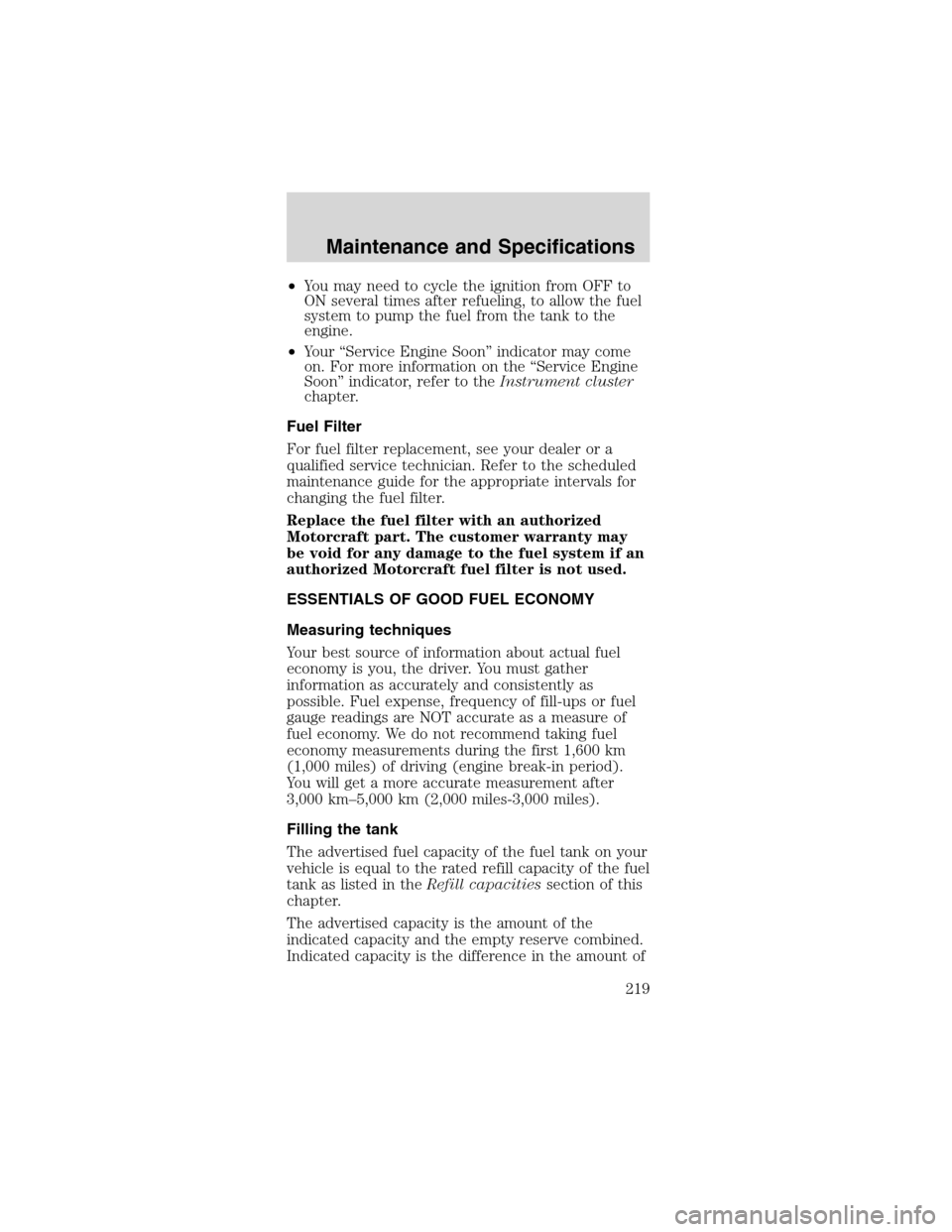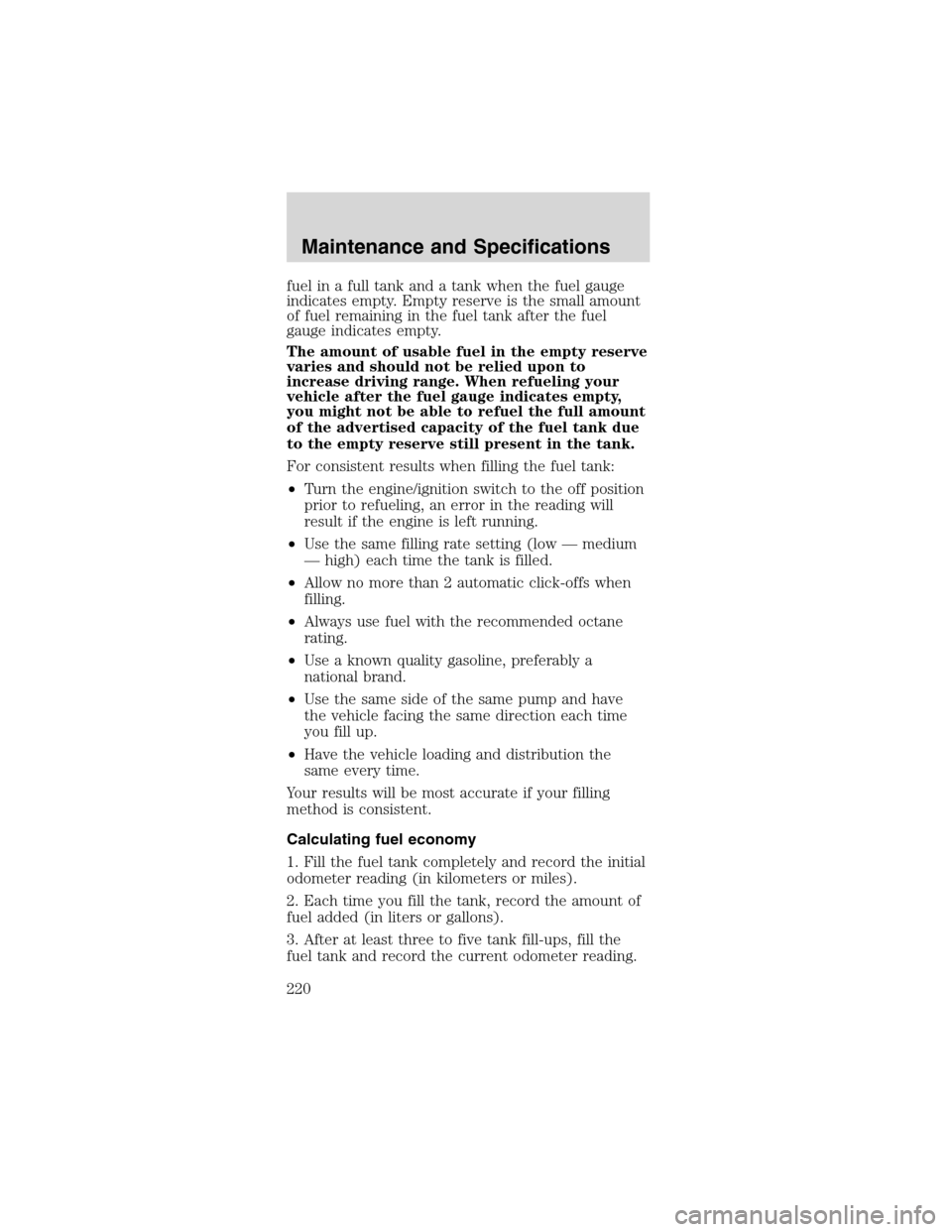Page 2 of 256
Brakes 138
Traction control/AdvanceTrac 142
Transmission operation 144
Vehicle loading 154
Trailer towing 156
Roadside Emergencies 157
Getting roadside assistance 157
Hazard flasher switch 158
Fuel pump shut-off switch 159
Fuses and relays 160
Changing tires 165
Jump starting 170
Wrecker towing 175
Customer Assistance 176
Reporting safety defects (U.S. only) 186
Cleaning 187
Maintenance and Specifications 194
Engine compartment 197
Engine oil 199
Battery 203
Fuel information 214
Part numbers 237
Refill capacities 238
Lubricant specifications 240
Accessories 245
Index 248
All rights reserved. Reproduction by any means, electronic or
mechanical including photocopying, recording or by any
information storage and retrieval system or translation in
whole or part is not permitted without written authorization
from Ford Motor Company. Ford may change the contents
without notice and without incurring obligation.
Copyright © 2002 Ford Motor Company
Table of Contents
2
Page 17 of 256
When refueling the vehicle from empty indication,
the amount of fuel that can be added will be less
than the advertised capacity due to the reserve fuel.
The FUEL DOOR icon and arrow indicates which
side of the vehicle the fuel filler door is located.
Speedometer
Indicates the current vehicle speed.
•Base instrument
cluster gauge
•Optional instrument
cluster gauge
Odometer
Registers the total
kilometers (miles) of
the vehicle.
Tachometer
Indicates the engine speed in revolutions per
minute.
Driving with your tachometer pointer at the top of
the scale or in the red zone may damage the engine.
Instrument Cluster
17
Page 219 of 256

•You may need to cycle the ignition from OFF to
ON several times after refueling, to allow the fuel
system to pump the fuel from the tank to the
engine.
•Your“Service Engine Soon”indicator may come
on. For more information on the“Service Engine
Soon”indicator, refer to theInstrument cluster
chapter.
Fuel Filter
For fuel filter replacement, see your dealer or a
qualified service technician. Refer to the scheduled
maintenance guide for the appropriate intervals for
changing the fuel filter.
Replace the fuel filter with an authorized
Motorcraft part. The customer warranty may
be void for any damage to the fuel system if an
authorized Motorcraft fuel filter is not used.
ESSENTIALS OF GOOD FUEL ECONOMY
Measuring techniques
Your best source of information about actual fuel
economy is you, the driver. You must gather
information as accurately and consistently as
possible. Fuel expense, frequency of fill-ups or fuel
gauge readings are NOT accurate as a measure of
fuel economy. We do not recommend taking fuel
economy measurements during the first 1,600 km
(1,000 miles) of driving (engine break-in period).
You will get a more accurate measurement after
3,000 km–5,000 km (2,000 miles-3,000 miles).
Filling the tank
The advertised fuel capacity of the fuel tank on your
vehicle is equal to the rated refill capacity of the fuel
tank as listed in theRefill capacitiessection of this
chapter.
The advertised capacity is the amount of the
indicated capacity and the empty reserve combined.
Indicated capacity is the difference in the amount of
Maintenance and Specifications
219
Page 220 of 256

fuel in a full tank and a tank when the fuel gauge
indicates empty. Empty reserve is the small amount
of fuel remaining in the fuel tank after the fuel
gauge indicates empty.
The amount of usable fuel in the empty reserve
varies and should not be relied upon to
increase driving range. When refueling your
vehicle after the fuel gauge indicates empty,
you might not be able to refuel the full amount
of the advertised capacity of the fuel tank due
to the empty reserve still present in the tank.
For consistent results when filling the fuel tank:
•Turn the engine/ignition switch to the off position
prior to refueling, an error in the reading will
result if the engine is left running.
•Use the same filling rate setting (low—medium
—high) each time the tank is filled.
•Allow no more than 2 automatic click-offs when
filling.
•Always use fuel with the recommended octane
rating.
•Use a known quality gasoline, preferably a
national brand.
•Use the same side of the same pump and have
the vehicle facing the same direction each time
you fill up.
•Have the vehicle loading and distribution the
same every time.
Your results will be most accurate if your filling
method is consistent.
Calculating fuel economy
1. Fill the fuel tank completely and record the initial
odometer reading (in kilometers or miles).
2. Each time you fill the tank, record the amount of
fuel added (in liters or gallons).
3. After at least three to five tank fill-ups, fill the
fuel tank and record the current odometer reading.
Maintenance and Specifications
220